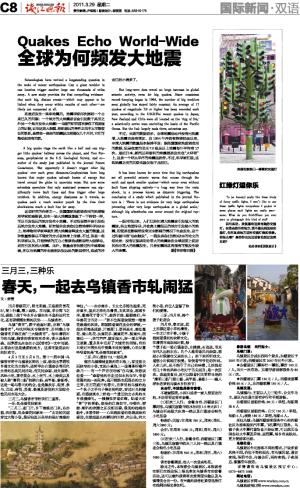Quakes Echo World-Wide全球为何频发大地震
Seismologists have revived a longstanding question in the wake of recent earthquakes: Can a giant temblor in one location trigger another large one thousands of miles away。A new study provides the first compelling evidence that such big, distant events─which may appear to be linked when they occur within months of each other─are likely not connected at all.
在最近发生一连串地震后,地震学家再次提起一个由来已久的问题:一个地方的大地震是否会引发数千英里之外另一个地方发生大地震?一项新的研究首次提供了有说服力的证据,证明这类大规模、相距遥远的事件之间不太可能有任何联系,虽然在一连串的地震彼此相隔仅几个月时,它们可能看起来有关联。
A big quake rings the earth like a bell and can trigger little quakes' halfway across the planet, said Tom Parsons, geophysicist at the U.S. Geological Survey, and co-author of the study just published in the journal Nature Geoscience. 'But apparently it doesn't trigger other big quakes' over such great distances.Geophysicists have long known that major quakes unleash bursts of energy that travel around the globe in uncertain ways. But now some scientists speculate that only sustained pressure can significantly move fault lines and thus trigger other large temblors. In addition, energy dissipates as it travels, so quakes pack a much weaker punch by the time their shockwaves reach a fault line far away.
这项研究的作者之一、美国国家地质调查局的地球物理学家帕森斯说,发生一场大地震就像敲了一下铃铛一样,可以引发很远的地方发生小地震。不过很显然不会引发很远地方发生大地震。研究报告发表在《自然地球科学》杂志上。地球物理学家早就知道大地震会释放出大量的能量,这种能量能够以不确定的方式在地球上传播。不过,现在一些科学家认为,只有持续的压力才能够造成断层带大幅移动,进而引发其他大地震。此外,能量会在传播过程中逐渐减弱,所以当地震的冲击波到达很远处的断层带时,造成的冲击已经小得多了。
But long-term data reveal no large increase in global seismic activity, even for big quakes. Since consistent record-keeping began in 1964, the number of big temblors seen globally has stayed fairly constant: An average of 17 quakes of magnitude 7.0 or higher has been recorded each year, according to the USGS.The recent quakes in Japan, New Zealand and Chile were all located on the 'ring of fire,' a seismically active zone encircling the basin of the Pacific Ocean. But the link largely ends there, scientists say.
不过,长期的数据显示,全球地震活动并没有出现激增,大地震也没有增加。自1964年开始有持续纪录以来,全球大地震的数量基本保持不变:据美国国家地质调查局的数据,记录在案的里氏7.0级及以上地震每年平均有17次。最近日本、新西兰和智利的地震都是发生在“火环带”上,这是一个环太平洋的地震活跃带。不过,科学家们说,这些地震之间的关联也就仅限于此而已。
It has been known for some time that big earthquakes set off powerful seismic waves that course through the earth and spark smaller quakes─which occur even without fault lines slipping entirely─a long way from the main shock, in a process known as dynamic triggering. The conclusion of a study which published in the journal Nature is : 'There is not evidence for very large earthquakes promoting other very large earthquakes at a global scale,' although big aftershocks can occur around the original rupture.
一段时间以来,人们已经知道大地震会引发强大的地震波,经由地面传导,并在离主震很远的地方引发较小的地震,即使是在断裂带没有完全断裂的情况下也会发生。这个过程被叫做“动态触发”。一篇发表在《自然》杂志的论文的结论是:没有证据表明非常大的地震会在全球层面上促进其他非常大的地震发生,只是初震地区周围有可能发生较大的余震。据《华尔街日报》
